New York City Landmarks Preservation Commission
The New York City Landmarks Preservation Commission (LPC) is the New York City agency charged with administering the city's Landmarks Preservation Law. The Commission was created in April 1965 by Mayor Robert F. Wagner Jr.[1] following the destruction of Pennsylvania Station the previous year to make way for the construction of the current Madison Square Garden. The Commission is responsible for protecting New York City's architecturally, historically, and culturally significant buildings and sites by granting them landmark or historic district status, and regulating them once they're designated. It is the largest municipal preservation agency in the nation.[2]
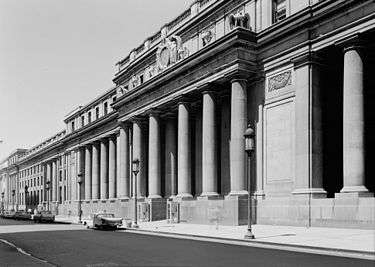
The Landmarks Preservation Commission consists of 11 commissioners, and is required by law to include a minimum of three architects, a historian, a city planner or landscape architect, a realtor and at least one resident of each of the five New York City boroughs.[2]
According to the Landmarks Preservation Law, a building must be at least thirty years old before the Commission can declare it a landmark.[3] City law also allows for the Commission's decision to be overturned if an appeal is filed within 90 days.[4]
Role
The goal of New York City's landmarks law is to preserve the aesthetically and historically important buildings, structures, and other objects that make up the New York City vista. The Landmarks Preservation Commission is responsible for deciding which properties should be subject to landmark status and enacting regulations to protect the aesthetic and historic nature of these properties. These regulations are generally designed to allow property owners to continue to use and maintain their properties, while preserving the important architectural characteristics of the properties. The commission preserves not only architecturally significant buildings, but the overall historical sense of place of neighborhoods that are designated as historic districts.[5] The commission is responsible for overseeing a range of designated landmarks in all five boroughs ranging from the Fonthill Castle in the North Bronx, built in 1852 for the actor Edwin Forrest, to the 1670s Conference House in Staten Island, where Benjamin Franklin and John Adams attended a conference aimed at ending the Revolutionary War.
The Commission helps preserve the City's landmark properties by regulating changes to their significant features.[6] The role of the Commission has evolved over time, especially with the changing real estate market in New York City.[7]
Types
As of July 1, 2020, there are more than 37,000 landmark properties in New York City, most of which are located in 150 historic districts in all five boroughs. The total number of protected sites includes 1,439 individual landmarks, 120 interior landmarks, and 11 scenic landmarks.[2] Some of these are also National Historic Landmark (NHL) sites, and many are on the National Registered Historic Places (NRHP).[2][8]
- Individual landmark: The exteriors of objects or structures; the interior is not included unless designated separately. Individual landmarks must be at least 30 years old and contain "a special character or special historical or aesthetic interest or value as part of the development, heritage, or cultural characteristics of the City, state, or nation".[9]
- Interior landmark: The interiors of structures, which fit the individual landmark criteria and are "customarily open or accessible to the public".[9]
- Scenic landmark: Sites owned by the city, which fit the individual landmark criteria and are "parks or other landscape features".[9]
- Historic districts: Regions with buildings that fit the individual landmark criteria and contain "architectural and historical significance". Landmark districts must also be geographically cohesive with a "coherent streetscape" and a "sense of place".[9]
History

The Commission was created in 1965 through groundbreaking legislation signed by Mayor Robert F. Wagner in response to the mounting losses of historically significant buildings in New York City, most infamously Pennsylvania Station.[1]
The Landmarks Preservation Commission's first public hearing occurred in September 1965 over the future of the Astor Library on Lafayette Street in Manhattan. The building was designated a New York City Landmark. Subsequently, the building was adaptively reused as The Public Theater.[10] Twenty-five years later, the Commission was cited by David Dinkins as having preserved New York City's municipal identity and enhanced the market perception of a number of neighborhoods. This success is believed to be due, in part, to the general acceptance of the commission by the city's developers.[5]
The Commission was headquartered in the Mutual Reserve Building from 1967 to 1980,[11] and later the Old New York Evening Post Building from 1980 to 1987.[12]
In 1989, when the Commission and its process was under review following a panel created by Mayor Koch in 1985,[13] a decision was made to change the process by which buildings are declared to be landmarks[14] due to some perceived issues with the manner by which the Commission operates[1] as well as the realization that the destruction feared when the Commission was formed was no longer imminent.[13]
In its first 25 years of existence, the Commission designated 856 buildings, 79 interiors and 9 parks or other outdoor places as landmarks, while declaring 52 neighborhoods with more than 15,000 buildings as historic districts.[1]
Prominent court decisions
One of the most prominent decisions in which the Commission was involved was the preservation of the Grand Central Terminal with the assistance of Jacqueline Kennedy Onassis.[15] In 1978, the United States Supreme Court upheld the law in Penn Central Transportation Co., et al. v. New York City, et al., stopping the Penn Central Railroad from altering the structure and placing a large office tower above it.[16] This success is often cited as significant due to the Commission's origins following the destruction of Pennsylvania Station, referred to by some as architectural vandalism.[1]
In 1989, the Commission designated the Ladies' Mile Historic District.[17] The next year marked the first time in the Commission's history that a proposed landmark, the Guggenheim Museum (one of the youngest declared landmarks), received a unanimous vote by the Commission members.[3] The vast majority of the Commission's actions are not unanimous by the Commission members or the community with a number of cases including: St. Bartholomew's Episcopal Church, Bryant Park and a number of Broadway theatres resulting in challenges.[18] One of the most controversial properties was 2 Columbus Circle, which remained at the center of a discussion over its future for a number of years.[19]
Cultural landmarks, such as Greenwich Village's Stonewall Inn, are recognized as well not for their architecture, but rather for their location in a designated historic district.[20]
In a heatedly discussed decision on August 3, 2010, the Commission unanimously declined to grant landmark status to a building on Park Place in Manhattan, and thus did not block the construction of Cordoba House.[21]
South Street Seaport and "New Market Building"
A commission-designated historic district for the South Street Seaport has been active since 1977 and was extended on July 11, 1989.[22] After the Fulton Fish Market relocated to the Bronx in 2005, community members, with leadership from organizer Robert Lavalva,[23] developed the "New Amsterdam Market", a regular gathering with vendors selling regional and "sustainable" foodstuffs outside the old Fish Market buildings. The group's chartered organization planned eventually to attempt to reconstitute the "New Market Building", a 1939 structure with an Art Deco façade[24] and that was owned by the city, into a permanent food market. However, a real estate company, the Howard Hughes Corporation, possessed a lease for large parts of the Seaport area and desired to redevelop it, generating fears among locals that the New Market Building would be altered or destroyed.[24] The corporation has offered to provide a more modest food market (at 10,000 sq ft (930 m2)) into their development plans, but market organizers have not been satisfied as they believe this proposal is not guaranteed or large enough, and would still not ensure the protection of the historic building.[25]
A group of community activists formed the "Save Our Seaport Coalition" to advocate that the New Market Building be incorporated into the historic district set by the Landmarks Preservation Commission, in addition to calling for the protection of public space in the neighborhood and for support for the seaport's museum. This group included the Historic Districts Council, the "Save Our Seaport" community group, the New Amsterdam Market, and the Metropolitan Waterfront Alliance.[26] The "Save Our Seaport" group specifically argued that New Market Building was culturally important for its maintenance of the historic fish market for 66 years, and that it offers a "fine example of WPA Moderne municipal architecture (an increasingly rare form throughout the nation)."[27] They had encouraged others to write letters to the Landmarks Preservation Commission to support formal designation or district protection.[27] However, in 2013, the Landmarks Preservation Commission declined to hold a hearing to consider this landmark designation or to expand the district.[24] Community Board 1 supports protecting and repurposing the New Market Building,[24] and the Municipal Art Society argued in a report that "[it] has both architectural and cultural significance as the last functioning site of the important commercial and shipping hub at South Street Seaport." [28]
Little Syria and Washington Street
After the September 11 attacks in 2001, New York City tour guide Joseph Svehlak and other local historians became concerned that government-encouraged development in Downtown Manhattan would lead to the disappearance of the last physical heritage of the once "low-rise" Lower West Side of Manhattan.[29] Also known as "Little Syria" in the late 19th and early 20th centuries, the area between Battery Park and the World Trade Center site, east of West Street and west of Broadway,[30] had been a residential area for the shipping elite of New York in the early 19th century, and turned into a substantial neighborhood of ethnic immigration in the mid-19th century. In the late 19th and early 20th centuries, centered on Washington Street, the area became well known as Little Syria, hosting immigrants from today's Lebanon, Syria, and Palestine, as well those of many other ethnic groups including Greeks, Armenians, Irish, Slovaks, and Czechs. Due to eminent domain actions associated with the construction of the Brooklyn–Battery Tunnel and the World Trade Center,[31] in addition to significant highrise construction in the 1920s and 30s, only a small number of low-rise historic buildings from the earlier eras remain.
In 2003, Svehlak wrote a manifesto arguing for the landmark designation of "a trilogy"[32] of three contiguous buildings on Washington Street, the thoroughfare that was most closely associated with "Little Syria." These consisted of the Downtown Community House – which hosted the Bowling Green Association to serve the neighborhood's immigrants – 109 Washington Street (an 1885 tenement), and the terra-cotta St. George's Syrian Catholic Church. After years of advocacy, in January 2009, the Commission held a hearing about the landmark designation of the Melkite church, which did succeed.[33] However, under Chairman Robert Tierney, the Commission had declined to hold hearings on the Downtown Community House or 109 Washington Street.
Community and preservation groups — including the "Friends of the Lower West Side" and the "Save Washington Street" group led by St. Francis College student Carl "Antoun" Houck[34] — have continued, especially, to advocate for a hearing on the Downtown Community House, arguing that its history demonstrates the multi-ethnic heritage of the neighborhood, and that its Colonial Revival architecture intentionally links the immigrants to the foundations of the country,[35] and that preserving the three buildings together would tell a coherent story of an overlooked, but important ethnic neighborhood.[31] In addition to national Arab-American organizations,[36] Manhattan Community Board 1[37] and City Councilperson Margaret Chin[38] have also advocated for the Commission to hold a hearing on the Downtown Community House. According to the Wall Street Journal, however, the Commission argues that "the buildings lack the necessary architectural and historical significance and that better examples of the settlement house movement and tenements exist in other parts of the city."[31] The activists have said they hope that the Commission under the new mayor will be more receptive to preservation in the neighborhood.[37]
Former landmarks
Very rarely, a landmark status granted by the LPC has been revoked. Some have been revoked by vote of the New York City Council or before 1990, the New York City Board of Estimate. Others have been demolished, either through neglect or for development, and revoked by the LPC.[39]
| Landmark name | Image | Date designated | Date removed | Location | Notes |
|---|---|---|---|---|---|
| 71 Pearl Street | May 17, 1966 | 1968 | Manhattan | ||
| 135 Bowery | June 29, 2011[41] | September 16, 2011[42] | Manhattan | The building was demolished in 2012.[43] | |
| Austin, Nichols and Company Warehouse | 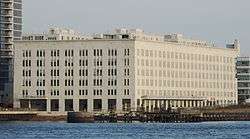 |
September 20, 2005 | November 30, 2005[44] | Brooklyn | Landmark 2163 |
| Beth Hamedrash Hagodol | 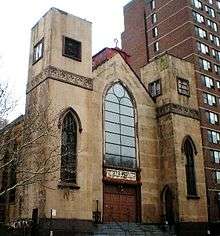 |
February 28, 1967 | Manhattan | ||
| Cathedral of St. John the Divine | 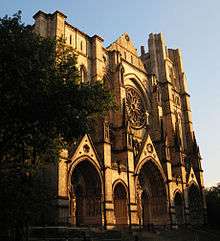 |
June 17, 2003 | October 25, 2003[46] | Manhattan | |
| Dvorak House, 327 East 17th Street | February 1991[48] | June 1991 | Manhattan | The building was demolished.[49] | |
| First Avenue Estate | 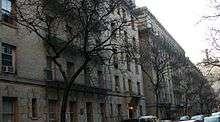 |
April 24, 1990[50] | August 16, 1990[51] | Manhattan | |
| Jamaica Savings Bank, Elmhurst Branch | June 28, 2005[50] | October 20, 2005[53] | Queens | Landmark 2173 | |
| Jerome Mansion | 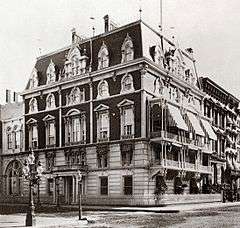 |
November 21, 1965[40] | June 23, 1966[54] | Manhattan |
|
| Lakeman-Cortelyou-Taylor House | December 13, 2016[56] | March 2017 | Staten Island | Landmark 2444 | |
| New Brighton Village Hall | 1965 | December 12, 2006[57] | Staten Island |
| |
| Public School 31 | July 15, 1986 | December 10, 2019[58] | Bronx | ||
| Samuel H. & Mary T. Booth House | November 28, 2017[60] | March 12, 2018[50] | Bronx | Landmark 2488 | |
| Stafford "Osborn" House | November 28, 2017[60] | March 12, 2018[50] | Bronx | Landmark 2479 | |
| Steinway Historic District | November 28, 1974[50] | January 23, 1975[61] | Queens |
See also
- New York City Office of Administrative Trials and Hearings (OATH), for hearings conducted on summonses for quality of life violations issued by the Commission
- List of New York City Landmarks
References
Notes
- Goldberger, Paul (April 15, 1990). "Architecture View; A Commission that has Itself Become a Landmark". The New York Times. Retrieved March 17, 2008.
- "About LPC". New York City Landmarks Preservation Commission; Government of New York City. Retrieved May 28, 2020.
- Staff (August 19, 1990). "Guggenheim Museum Is Designated a Landmark". The New York Times. Retrieved March 17, 2008.
- Dunlap, David W. (November 5, 1987). "5 More Broadway Theaters Classified as Landmarks". The New York Times. Retrieved March 17, 2008.
- Dunlap, David W. (April 29, 1990). "Change on the Horizon for Landmarks". The New York Times. Retrieved March 17, 2008.
- "Apply for a Permit". Landmarks Preservation Commission. Retrieved April 23, 2014.
- Tarquinio, Alex (October 3, 2007). "New Buildings That Embrace the Old". The New York Times.
- "Landmark Designation". New York City Landmarks Preservation Commission; Government of New York City. Retrieved May 28, 2020.
- "Landmark Types and Criteria". New York City Landmarks Preservation Commission; Government of New York City. Retrieved December 22, 2019.
- Gilbert, Frank B. (November 13, 1991). "Papp Proved that Landmarks Law Works (letter to the editor)". The New York Times. Retrieved March 17, 2008.
- Colvin, Jill (December 21, 2011). "Former Home of Macy's and Mutual Reserve Building Become City Landmarks". DNAinfo. Archived from the original on March 20, 2017. Retrieved March 19, 2017.
- Diamonstein-Spielvogel, Barbaralee (2011), The Landmarks of New York, Albany, New York: State University of New York Press, ISBN 978-1-4384-3769-9. p.283
- Dunlap, David W. (December 27, 1987). "Advisory Group to Determine Future of Landmarks Board". The New York Times. Retrieved March 17, 2008.
- Dunlap, David W/ (February 6, 1989). "Panel Urges Deadlines for Votes on Landmarks". The New York Times. Retrieved March 17, 2008.
- Meistersinger, Toby von (March 7, 2008). "Some Grand Central Terminal Secrets Revealed". Gothamist. Archived from the original on March 10, 2008. Retrieved March 17, 2008.
- Goldberger, Paul (June 4, 1977). "Office Tower Above Grand Central Barred by State Court of Appeals". The New York Times. Retrieved March 17, 2008.
- Staff. (May 7, 1989) "Ladies' Mile District Wins Landmark Status," The New York Times
- Dunlap, David W. (November 11, 1988). "Chairman Plans to Leave Panel on Landmarks". The New York Times. Retrieved March 17, 2008.
- Weiner, Alan S. (October 13, 2003). "The Building That Isn't There". The New York Times. Archived from the original on October 3, 2015. Retrieved March 17, 2008.
- Dunlap, David W. (June 26, 1999). "Stonewall, Gay Bar That Made History, Is Made a Landmark". The New York Times. Retrieved March 17, 2008.
- Hernandez, Javier C. (August 3, 2010). "Mosque Near Ground Zero Clears Key Hurdle". The New York Times. Retrieved August 7, 2011.
- Historic Districts Council. "South Street Seaport." Retrieved August 11, 2014.
- Hanania, Joseph. (January 24, 2014) "Duel at the Old Fulton Fish Market" The New York Times Retrieved: August 12, 2014.
- Kreuzer, Terese Loeb (September 12, 2013) "City says no to landmarking Seaport building, leaving door open to demolition" Downtown Express. Retrieved August 12, 2014.
- Reynolds, Aline. (March 20, 2013) "Food Market For Seaport In Last-Minute Deal Over Pier 17" Tribeca Tribune. Retrieved: August 12, 2014.
- Garfinkel, Molly (ndg) "New Market Building is Place Matters building of the month!". Historic Districts Council. Retrieved: August 12, 2014
- Save Our Seaport. "Support Seaport Landmark Preservation" Retrieved: August 12, 2014.
- Municipal Art Society (2008) "Fulton Fish Market: New Market Building" Retrieved: August 12, 2014.
- Wilensky-Lanford, Brook. (June 3, 2013) "Discovering 'Little Syria' — New York's Long-Lost Arab Neighborhood" Religion Dispatches Retrieved August 10, 2014.
- Chowdhury, Sudeshna. (June 20, 2013) "Arab Americans Aim at Preserving New York's Little Syria" Inter Press Service. Retrieved August 10, 2014.
- Weiss, Jennifer (March 25, 2013) "In Lower Manhattan, Memories of 'Little Syria'" The Wall Street Journal p. A18 Retrieved: August 10, 2014
- McFarlane, Skye H. (April 27 – May 3, 2007) "Tour guide looks to save remnants of 'Little Syria'" Downtown Express. Retrieved: August 10, 2014.
- Caratzas, Michael D. (July 14, 2009) "{Former} St. George's Syrian Church Designation Report" Archived February 11, 2018, at the Wayback Machine. New York City Landmarks Preservation Commission
- Dunlap, David W. (January 2, 2012) "An Effort to Save the Remnants of a Dwindling Little Syria" The New York Times p. A18. Retrieved August 10, 2014.
- Eakin, Britain (August 4, 2013) "Activists lobby 9/11 Memorial to remember ‘Little Syria'". Al-Arabiya. Retrieved August 10, 2014.
- Wallace, Bruce (January 19, 2012) "Saving New York's 'Little Syria'" PRI's The World Retrieved: August 10, 2014.
- Malek, Alia (October 27, 2013) "Rediscovering 'Little Syria' after the storm passed" Aljazeera America Retrieved August 10, 2014.
- Khan, Taimur (September 21, 2013) "In New York's Little Syria, a fight to preserve the past" The National (Abu Dhabi)) p. A18. Retrieved: August 10, 2014.
- Sternberg, Joachim Beno (April 2011). "New York City's Landmarks Law and the Rescission Process" (PDF). New York University. Retrieved June 14, 2020.
- Nevius, James (April 29, 2015). "How Some of NYC's First Landmarked Buildings Became Rubble". Curbed. Retrieved June 14, 2020.
- "135 Bowery is Landmarked!". Bowery Boogie. June 29, 2011. Retrieved June 14, 2020.
- "City Council subcommittee turns down Landmarks designation of 135 Bowery". The Real Deal New York. September 15, 2011. Retrieved June 14, 2020.
- "Demolished 135 Bowery Up For Sale". Bowery Boogie. September 4, 2012. Retrieved June 14, 2020.
- Berkey-Gerard, Mark. "City Council Stated Meeting - November 30, 2005". Gotham Gazette. Retrieved October 31, 2019.
- "Fire Tears Through Historic Beth Hamedrash Hagodol Synagogue on LES: FDNY". DNAinfo New York. May 14, 2017. Retrieved June 14, 2020.
- Hu, Winnie (October 25, 2003). "No Landmark Status for St. John the Divine". The New York Times. ISSN 0362-4331. Retrieved June 14, 2020.
- Rosenberg, Zoe (February 21, 2017). "Cathedral of St. John the Divine finally becomes a NYC landmark". Curbed NY. Retrieved June 14, 2020.
- Prial, Frank J. (February 27, 1991). "Dvorak House Declared A Manhattan Landmark". The New York Times. ISSN 0362-4331. Retrieved June 14, 2020.
- Lii, Jane H. (September 21, 1997). "NEIGHBORHOOD REPORT: STUYVESANT SQUARE; Dvorak, Back Home at Last". The New York Times. ISSN 0362-4331. Retrieved June 13, 2020.
- "9 NYC Buildings that Have Lost Their Landmark Status". Untapped New York. March 4, 2020. Retrieved June 13, 2020.
- Purdum, Todd S. (August 16, 1990). "On Estimate Board's Agenda, Last Item Is Its Own Demise". The New York Times. ISSN 0362-4331. Retrieved June 13, 2020.
- "City and Suburban Homes Company, First Avenue Estate" (PDF). New York City Landmarks Preservation Commission. April 24, 1990. Retrieved June 13, 2020.
- Steele, Lockhart (October 28, 2005). "Elmhurst's Jamaica Savings Bank: Landmark Or Not?". Curbed NY. Retrieved June 13, 2020.
- Manhattan Club v. Landmarks Comm, 51 Misc. 2d 556 (N.Y. Sup. Ct. June 23, 1966).
- Mendelsohn, Joyce (1998), Touring the Flatiron: Walks in Four Historic Neighborhoods, New York: New York Landmarks Conservancy, p. 26, ISBN 0-964-7061-2-1, OCLC 40227695
- Sommer, Cassy (December 13, 2016). "2 Staten Island buildings named landmarks, as backlog initiative ends". silive. Retrieved June 14, 2020.
- "Landmark Site of Former New Brighton Village Hall" (PDF). New York City Landmarks Preservation Commission. December 12, 2006. Retrieved June 11, 2020.
- "Landmarks Rescind Landmarks Designation Status of Former School". CityLand. December 11, 2019. Retrieved June 14, 2020.
- Dunlap, David W. (January 8, 2014). "Bronx Landmark, Under City's Care, Is on Brink of Demolition". The New York Times. ISSN 0362-4331. Retrieved June 14, 2020.
- Small, Eddie (November 28, 2017). "Two age-old homes on City Island are now landmarks". The Real Deal New York. Retrieved June 14, 2020.
- Fowler, Glenn (January 24, 1975). "City Nullifies Designation Of Steinway Historic Area". The New York Times. ISSN 0362-4331. Retrieved June 13, 2020.
External links
- Official website
- Landmarks Preservation Commission in the Rules of the City of New York
- New York City Landmarks Preservation Commission flickr Group